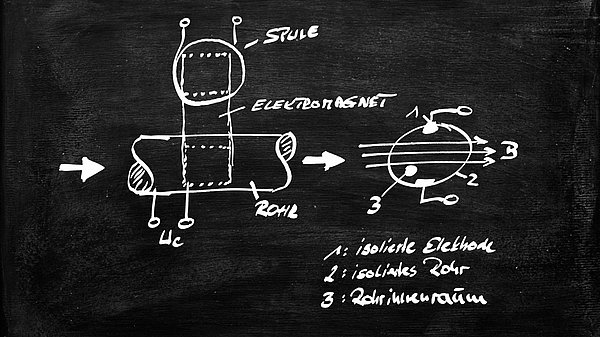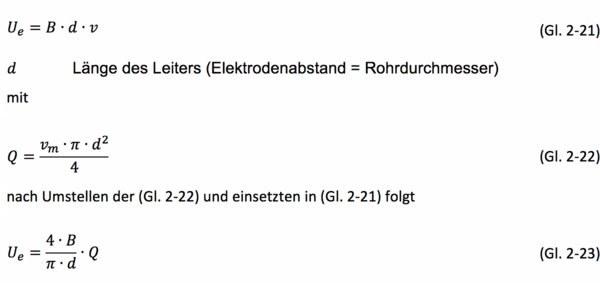GRX-Q - Electromagnetic flow measurement
In electromagnetic flow measurement, an electrical voltage is generated by the interaction between the flow velocity of a liquid and a magnetic field. This principle is based on Faraday's law of induction. According to this law, an electric field strength is generated by an electrically conductive liquid flowing through a magnetic field.
The medium flows through an insulated lined pipe. Two diametrically opposed electrodes are attached to the pipe wall, which are perpendicular to the magnetic field and the direction of flow (see Fig. 2-14). The voltage tapped via the electrodes is proportional to the average flow velocity. A transmitter is used to separate the useful signal from the considerably larger interference signal. A laminar-flowing fluid is required to keep the measurement error as low as possible. For this purpose, a calming distance of three to five times the pipe diameter should be provided. This should also be taken into account for previous cross-sectional changes and bends.

The type of signal processing is determined by the field excitation (direct or alternating field). Alternating fields prevent electrochemical polarization of the electrodes. The physical basis is based on the Lorentz field strength E (eq. 2-20).

With Ue=E∙d the equation (eq. 2-21) follows, provided that the velocity v is orthogonal to the direction of the field B:

From the (eq. 2-23) it can be seen that the voltage Ue is proportional to the volume flow rate Q. Although the electrical conductivity of the medium is not part of the equation, it must not fall below a lower limit value of approx. 100 µS/m. If the conductivity is lower, the measuring voltage Ue can collapse when the system is loaded by the input resistance of the measuring amplifier.
The advantages of this measuring principle are that the physical properties of the medium, such as pressure, temperature and viscosity, are independent. In addition, the system is practically wear and maintenance-free, as no mechanically moving parts are used. The method is well suited for measuring contaminated liquids such as sludge or solids. Likewise, no additional pressure loss is caused by an internal measuring body or a cross-sectional constriction. The analog output signal also has good linearity over a wide dynamic range.
However, the measuring principle can only be used with electrically conductive liquids. Deposits in the measuring tube can also cause cross-sectional constrictions that lead to measurement errors. The temperature restriction and the minimum flow velocity (up to 250 °C, min 0.5 m/s) are also disadvantageous.
In this article relevant products:
These articles from our magazine may also interest you:
Error during grinding
Although grinding is a widely used manufacturing process, it is still complex and carries the risk of making mistakes in many places. In all cases these affect efficiency and component quality. Here you can read about what needs to be paid attention to in detail and what the most common errors in grinding actually are.
Flowing bodies
With this type of flow measurement, the flow is applied to floating bodies, spring washers or flaps. After the differential pressure method, variable area flow measurement is one of the most frequently used methods.
Advantages of Coolant Monitoring Systems
Coolant monitoring systems can contribute significantly to increasing reliability and efficiency by collecting and evaluating various measurement and status data in the cooling lubricant system.
Displacement meter
In displacement meters, the movable measuring walls are driven by the medium to be measured. The movement is detected and counted.







